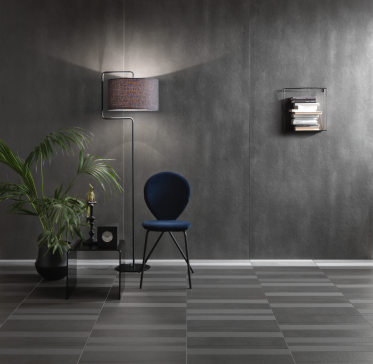
Pietra Grey matt kitchen island, bench and splashback at Soko Sky Homes. By Cottee Parker Architects. Image Mindi Cooke
The history of porcelain stems back to the 16th century BC when it was first made in China during the Shang dynasty. In the 16th century AD it began making its way to Europe via Portugal and in far more recent times, some Italian innovation has given new life to the purest of clays.
While porcelain plates and vases may pop up in many rooms of our homes, the innovation of Pressed Porcelain Panels (PPPs) has opened up many new doors of application – from kitchen benches to exterior cladding and everything in between. They are created through the process of pressing these large format, durable surfaces and here, HouseLab explores the inherent qualities – and how they apply to your home, room-by-room.

Travertino external cladding at Brighton House by Tim Roberts Design. Image by Michael Grazzola
COMPOSITION
Porcelain, like its other ceramic cousins, is made using all-natural materials though requires finer, more pure elements that combine to form many of its unique qualities. These elements are exposed to enormous pressure and intense heat during the production process of PPPs resulting in a surface that is both strong and fireproof, making them perfect for exterior cladding in flame zones or around a kitchen stove-top.
The fact that all these elements – soil, sand and water – have been exposed to the natural elements for thousands of years also makes them UV stable, an important factor in Australia when considering any surface that is exposed to constant sunlight. Just like the white sands and crystal-clear water of Jervis Bay, PPPs will hold their colour for eternity.
QUICK TIP
The material composition of PPPs make them ideal for:
External cladding
Kitchen benches and splash backs

Maximum Neptune flooring
THICKNESS
Being incredible strong, a key feature of PPPs is that they can be manufactured at thicknesses down to 6mm and 3mm yet still withstand a knock. Perhaps we should be saying thin-ness, but this feature adds a slimline dimension to the design of a hovering kitchen bench, shelving or bathroom vanity.
Additionally, as they are so delicate in depth, this opens up other possibilities as PPPs can be used internally on walls and floors – being the same thickness (if not thinner) than common materials like Gyprock and floorboards. They don’t encroach on your space any more than other cladding and this means you can match your cabinet doors to your walls and benches perfectly.
QUICK TIP
The strength and thickness of PPPs make them ideal for:
Floors and walls
Kitchen bench tops or bathroom vanities
Shelving
Cabinet doors

Gold Onyx kitchen joinery at Casa Artedomus by The Stella Collective and Thomas Coward Studio. Image Derek Swalwell
WEIGHT
Another bonus of PPP's strength and thickness is their weight or lack there-of. As they can be made so thin they weigh far less than a standard marble benchtop meaning they are easier to install and require less support – perfect for cupboard doors, drawers and shelving with no need for additional hinges or rails.
QUICK TIP
The lightweight nature of PPPs make them ideal for:
Cabinet doors
Drawer fronts
Shelving
SIZE
When it all comes together, the process of making PPPs means they can be pressed in large scales with panels coming in sizes up to 3000mm x 1500mm. Think about it – a modest balcony floor could be covered in one sheet, the walls reaching to a 3-metre ceiling can be clad in porcelain and a kitchen bench can be installed with no gaps meaning less time cleaning out the food and dust caught between surfaces.
And when it comes to bathrooms, the scale of PPPs gets really interesting. Ceramic tiles have been used to adorn the walls and floors of our wet-areas for as a long as anyone can remember but they are fiddly, time-consuming to install and hard to match if one cracks.
Using large format PPPs in the bathroom takes away these problems of time-consuming installation but it is not just the size that matters in this instance.
QUICK TIP
The large format of PPPs make them ideal for:
Walls and cladding
Kitchen benches
SCRATCH RESISTANCE
PPPs are highly resistant to scratching meaning that during both installation and use they have a minimum chance of damage. Combined with their strength, you will have a hard time damaging them, so one less headache trying to find that matching tile and have it replaced.
It also makes them perfect for flooring, benches and other high use areas where hard heels or sharp knives can come in contact but that doesn’t mean they don’t carry a texture of their own.
QUICK TIP
The resistance to scratching of PPPs make them ideal for:
Floors
Walls and cladding
Bathrooms

Moon kitchen island and splashback at H House by Marston Architects. Image Kat Lu
AESTHETICS
With all these functional capabilities, the true beauty of PPPs is in their aesthetic. As they are pressed, the moulds used can impress an array of patterns and incorporate many colours making selection of the right panels endless. The size of the sheets means that the manufacturers can press large scale patterns that match across multiple sheets.
Colours can vary as much as the shades of grey and when it comes to marbling, the beautiful thing is panels can be vein or book matched. Like aligning the grain in two pieces of timber, this means the pattern in the PPP can continue into the next sheet creating a consistent appearance. For walls and floors, this is a huge bonus and layered on top of all the other benefits of Pressed Porcelain Panels it makes the choice pretty obvious.
QUICK TIP
The aesthetic qualities of PPPs make them ideal for:
Floors
Walls
Kitchen benches
Bathrooms
Exterior cladding
_
For more information on Pressed Porcelain Panels and their applications contact Artedomus
WRITTEN BY HouseLab










